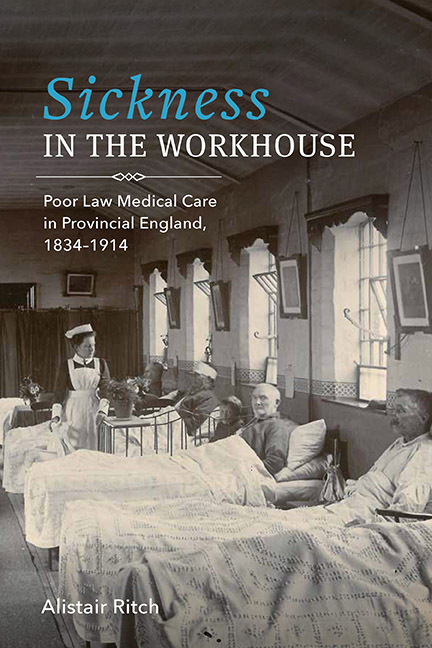Book contents
- Frontmatter
- Dedication
- Contents
- List of Tables
- Acknowledgments
- Introduction: Pauperism and Sickness
- 1 From Acute Illness to Chronic Disability
- 2 Segregating Fever Patients
- 3 Controlling Disorderly Behavior
- 4 Day-to-day Doctoring
- 5 Medical Therapies
- 6 Poor Law Nursing
- 7 “Every Care and Kindness”: The Standard of Workhouse Medicine
- Appendix A Prevalence of Selected Infectious Diseases in Birmingham Workhouse on the Last Day of the First Week of Each Quarter for the Years 1877–80 and 1894–1911
- Appendix B Medical Relief in Birmingham Workhouse for Selected Weeks, 1851–56
- Appendix C List of Drugs Kept in the Wards of Birmingham Infirmary in 1896
- Appendix D Pauperism Rates and Institutionalization Rates for Birmingham Parish, Wolverhampton Union, and England and Wales, 1840–1911
- Notes
- Bibliography
- Index
Introduction: Pauperism and Sickness
Published online by Cambridge University Press: 21 March 2020
- Frontmatter
- Dedication
- Contents
- List of Tables
- Acknowledgments
- Introduction: Pauperism and Sickness
- 1 From Acute Illness to Chronic Disability
- 2 Segregating Fever Patients
- 3 Controlling Disorderly Behavior
- 4 Day-to-day Doctoring
- 5 Medical Therapies
- 6 Poor Law Nursing
- 7 “Every Care and Kindness”: The Standard of Workhouse Medicine
- Appendix A Prevalence of Selected Infectious Diseases in Birmingham Workhouse on the Last Day of the First Week of Each Quarter for the Years 1877–80 and 1894–1911
- Appendix B Medical Relief in Birmingham Workhouse for Selected Weeks, 1851–56
- Appendix C List of Drugs Kept in the Wards of Birmingham Infirmary in 1896
- Appendix D Pauperism Rates and Institutionalization Rates for Birmingham Parish, Wolverhampton Union, and England and Wales, 1840–1911
- Notes
- Bibliography
- Index
Summary
In July 1841, Charles Hodgkins reported to the Board of Guardians of Wolverhampton Union that Anne, the wife of John Walford, was suffering from a disorder of her liver and bowels that was likely to last for six or seven weeks and resulted in her being “unable to follow any employ.” He added that both her sons required constant attention: John, aged two years, was “labouring under water on the brain,” and George, seven weeks old, also had a bowel disorder. Hodgkins, who had been appointed by the guardians as medical officer for Wolverhampton Union, arranged for them to receive four pounds of mutton and four loaves of bread per week for two weeks and planned to admit Anne after that time to the union workhouse, which had opened only two years previous. However, at the end of the two weeks, her condition had deteriorated to such an extent that Hodgkins regarded her recovery as very doubtful and removal to the workhouse as not prudent. The rations were continued for a further four weeks. Whether she recovered or not, we shall never know, but Hodgkins clearly saw the workhouse as a suitable place for treating a sick pauper.
Yet many poor law historians have claimed that workhouses did not develop a significant medical role until the late nineteenth century and emerged as the most important institutions for medical care only in the early twentieth century. Some have been highly critical of the standard of medical care provided in the early years after the New Poor Law, claiming a significant deterioration in the provision of medical services. As evidence, they point to the restriction of funding, the understaffing of infirmaries, and the undermining of medical officers’ decisions by guardians, who sought to treat patients as cheaply as possible. The conventional viewpoint denigrates medical care after the act as of such poor quality as to bring little benefit to sick paupers. However, the traditional history of the Poor Law Amendment Act (1834), usually referred to as the New Poor Law, as a watershed in the provision of medical services is now being challenged in favor of one of continuity of care across the eighteenth and nineteenth centuries.
- Type
- Chapter
- Information
- Sickness in the WorkhousePoor Law Medical Care in Provincial England, 1834–1914, pp. 1 - 28Publisher: Boydell & BrewerPrint publication year: 2019

